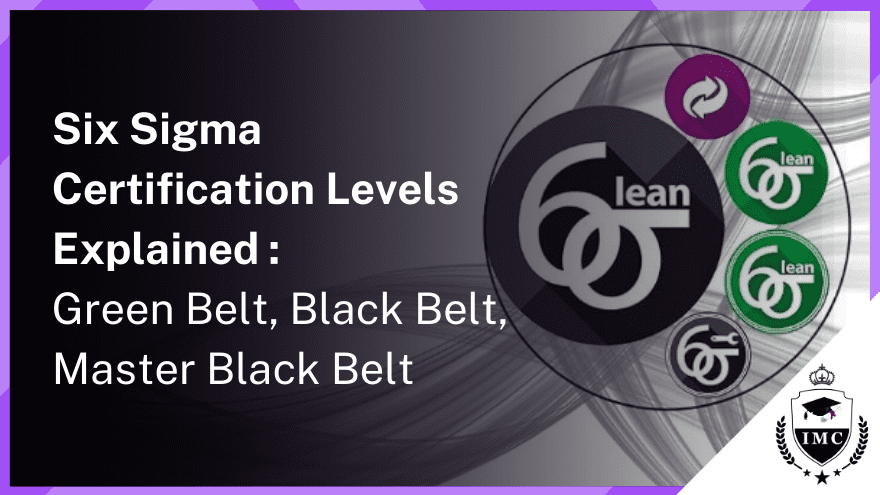Six Sigma has become an increasingly popular and powerful methodology for process improvement across many industries. Organizations around the world have adopted Six Sigma strategies to build cultures of continuous improvement and operational excellence. At the heart of Six Sigma's success are the specially trained experts who lead and implement these initiatives. Six Sigma professionals pursue certifications to validate their knowledge and competency in applying Six Sigma tools and techniques. In this blog post, we will explore the three main certification levels - Green Belt, Black Belt, and Master Black Belt. Understanding the distinctions between these credential levels can help Six Sigma practitioners choose the right certification to match their experience and career aspirations.
Green Belt Certification
A Six Sigma Green Belt is an associate-level certification. Green Belts are trained in Six Sigma fundamentals and DMAIC (Define, Measure, Analyze, Improve, Control) - the core methodology followed in Six Sigma projects. Green Belts work on process improvement projects part-time while maintaining their regular job responsibilities.
Some key benefits of a Green Belt certification include:
- Learning basic Six Sigma principles and tools like process mapping, root cause analysis, and data analytics.
- Improving processes and efficiency in one's own job role.
- Contributing to organizational quality and cost reduction goals.
- Building project management and problem-solving skills.
- Adding a credential to your resume that shows process improvement knowledge.
To earn a Green Belt, candidates must demonstrate their basic knowledge of Six Sigma tools and principles either through training or practical experience. Many options for Green Belt training and certification are available through accredited institutions, authorized training partners, or online courses. The exam tests a Green Belt's understanding of Six Sigma principles, their ability to interpret data, and skill in applying basic statistics.
Black Belt Certification
The Six Sigma Black Belt operates at a management level and leads complex process improvement projects full-time. Black Belts have an in-depth understanding of Six Sigma principles and tools such as statistical analysis and change management. They train and mentor Green Belts and other team members through executing Six Sigma projects.
Key benefits of a Black Belt certification include:
- Expert-level knowledge of Six Sigma tools and methodology.
- Leading high-impact continuous improvement initiatives.
- Coaching Green Belts and team members on process excellence.
- Contributing to major gains in quality, efficiency, and cost-savings.
- Highly valued certification for quality management and process improvement careers.
Earning a Black Belt certification requires candidates to demonstrate their proficiency through training, project execution, and exams. Candidates undergo rigorous preparation sessions, simulations, and statistical software training. They must complete at least two projects demonstrating mastery of DMAIC. Black Belt certification exams are comprehensive, testing procedural knowledge, analytical skills, and leadership abilities.
Master Black Belt Certification
Master Black Belts are the highest practitioners and trainers in Six Sigma methodology. They possess extensive knowledge and experience applying Six Sigma across various industries and organizations. Their primary focus is to mentor and coach Black Belts and Green Belts.
- The key advantages of a Master Black Belt certification include:
- Highest level of Six Sigma thought leadership and expertise.
- Coaching Black Belts and leading enterprise-wide continuous improvement culture.
- Developing Six Sigma training curriculum and strategy deployment.
- Career advancement to senior process excellence leadership roles.
- Becoming an internal or external consultant on Six Sigma strategy.
Master Black Belt certification has stringent requirements, including being an existing high-performing Black Belt. Candidates undergo advanced training in statistical analysis, change management, and other complex methodologies. They must demonstrate expertise by completing multiple projects, authoring publications, and developing curriculum. The certification process can take several years, ensuring the highest levels of Six Sigma thought leadership.
The Value of Six Sigma Certifications
Six Sigma certifications help professionals gain expertise in process improvement techniques that lead to better efficiency, quality, and profits. Organizations benefit from certified Six Sigma practitioners driving strategic continuous improvement initiatives. With various levels available, professionals can obtain Six Sigma credentials aligned with their experience and career goals.
The Benefits of Online Learning and Certification Programs
While traditional in-person training used to be the norm for Six Sigma certifications, online learning and certification programs are becoming increasingly popular. Online platforms offer a number of advantages for professionals pursuing Green Belt, Black Belt, or Master Black Belt credentials:
Flexibility and Convenience
Online Six Sigma training allows you to set your own schedule and pace for completing coursework. You can access learning modules and materials 24/7 without having to attend set class times. This flexibility is ideal for working professionals balancing a certification program with full-time jobs.
Cost Savings
Eliminating travel and other logistics costs associated with in-person training results in significant savings. Online courses are more affordable, making certifications economically accessible to more professionals. Organizations can also benefit from reduced employee training costs.
Customized Learning Experience
With self-paced online training, individuals can focus on subject areas most relevant to them and repeat difficult concepts. Programs with interactive modules, practice tests, and feedback let you customize your learning.
Instructor Support
Quality online courses still provide instructor interaction and support. Guidance from experts helps ensure you fully comprehend the material.
Exam Prep and Credibility
Reputable online programs are sanctioned by industry bodies like ASQ and IASSC. They prepare you thoroughly for certification exams, upholding the credibility and value of your Green Belt, Black Belt or Master Black Belt credential.* By leveraging the advantages of online platforms, professionals and organizations can reap the benefits of affordable, tailored Six Sigma training leading to certifications that enhance careers and process improvement capabilities.
Summary
The Six Sigma methodology relies on experts trained and certified at various competency levels. Green Belts learn core skills to work on localized process improvements part-time. Black Belts gain advanced expertise to lead high-impact projects full-time. Master Black Belts possess the highest degree of Six Sigma proficiency and mentor organizations at an enterprise level. Six Sigma certifications require developing skills through training, implementing projects, and passing exams. Each level builds on the previous one to provide professionals a path for career advancement in process excellence. Organizations benefit from certified Six Sigma experts driving continuous improvement aligned with strategic objectives. With a solid understanding of the tiered certification system, both individuals and companies can leverage Six Sigma for gains in quality, efficiency and cost reduction.






